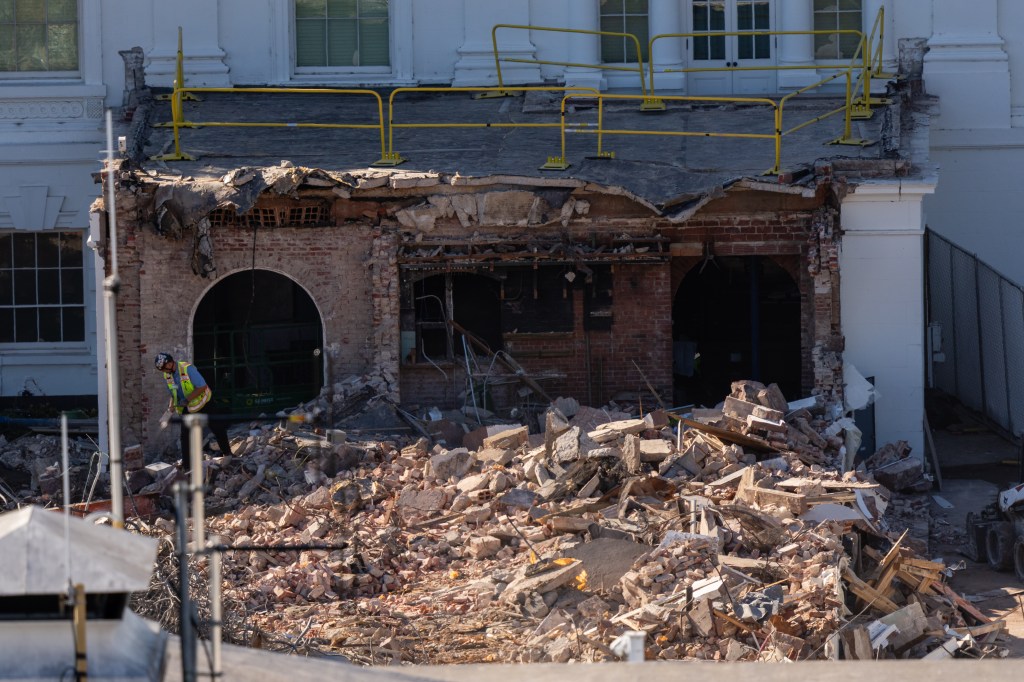Just outside the White House on Thursday, in the carnival atmosphere just outside the north gates, a woman bearing the sign that read “Geneva” shouted, over and over again, “The demolition is illegal! The demolition is a federal crime.”
Inside, at the White House briefing, Press Secretary Karoline Leavitt defended Donald Trump‘s demolition of the East Wing as very legal, even if that meant, as a reporter suggested, that he could “tear down whatever he wants.”
The sounds and images of heavy construction equipment ripping apart one of the most historic places in the United States, though, have put the White House on the defensive. In response to alarm and outrage from preservation groups to Democrats to some Republicans, Trump’s team has scrambled to point out the renovations of past presidents, and to make the case that what will be put in its place will be something better, what Leavitt called a “big, beautiful ballroom that can hold big parties and state visits for generations to come.”
That may ultimately be so, but what’s striking is the lack of any public input, congressional or commission review, while groups like the National Trust for Historic Preservation are sounding the alarm that what is planned for the space.
The $300-million ballroom is proposed to be 90,000 square feet, dwarfing the 55,000-square-foot executive mansion, and threatening to “permanently disrupt the carefully balanced classical design of the White House with its two smaller, and lower, East and West Wings,” warns the National Trust.
What’s more, Trump’s demolition go well beyond what he said over the summer — that the ballroom construction would “not interfere” with the existing building. Instead, not only is the East Wing gone, but so is the corridor that leads to it, known as the East Colonnade.
The president has also indicated that a portion of the East Room, in the main White House structure, would be removed to make way for a passageway to connect that space to the new ballroom.
Asked why Trump did not make clear his plans to tear down the East Wing, Leavitt told reporters that “with any construction projects there are changes…Trust the process.”
The East Wing is far lesser known than the West Wing, for obvious reasons, but it is familiar to anyone who has gone on a White House public tour, attended a holiday reception or, in the case of Hollywood, screened a movie there.
The East Wing, first built by Theodore Roosevelt in 1902 and expanded and overhauled by Franklin D. Roosevelt some 40 years later, has housed the offices of the first lady, a role that has expanded in recent decades, as the presidential spouses have amassed staffs and pursued social and cultural initiatives. Betty Ford championed the Equal Rights Amendment, Michelle Obama led Let’s Move and Melania Trump has promoted Be Best. It also was the site of other offices, like the social secretary and the White House calligrapher, while below is a bunker, known as the Presidential Emergency Operations Center.
What stood out on a visit was the relative quiet, a calmness that contrasted to the other side of the complex, where reporters hover in the briefing room and the double doors of the West Wing. Windows of the East Wing looked out over the Jacqueline Kennedy Garden, not to be confused with the Rose Garden, where Trump has paved over grass to make a patio space next to the Oval Office.
Connecting to the East Wing was the now gone corridor, which included the White House Family Theater. The 42-seat screening room, originally a cloak room, is officially a part of the private residence of the First Family, but its history from Eisenhower to Reagan was recorded by its longtime projectionist, Paul Fischer. (From this we know that Jimmy Carter holds the distinction of being the only president known to have watched an X-rated movie at the White House, Midnight Cowboy).
While many of the screenings were private, with the MPA supplying the most recent releases, at some the First Family invited filmmakers and stars, like Warren Beatty, who screened Reds there for the Reagans, and Nora Ephron, who was so irked by the quality of the Julie & Julia viewing experience that she went to the projection room to improve the focus. Barack Obama watched Monsters & Aliens there, the 3D glasses sent over by DreamWorks.
As the Trump White House embarks on a massive construction of the ballroom, something else may be lost as well.
What existed in the White House was a relative lack of ostentation — formal, but showing occasional signs of wear and tear, proof that this was a People’s House, not a palace. Subtlety trumped gilt, as the showplace for the president didn’t need to showoff to prove American greatness.
The renderings of the new ballroom show a giant windowed space with splashes of gold and room for some 900 people.
On Wednesday, Trump said that the new structure will be “one of the great ballrooms anywhere in the world.”
The East Wing, Trump said, “was never thought of being much, it was a very small building.”
It may have been a small space, but it was large in historic importance in the eyes of historians, preservationists and many who worked there or simply visited to roam its halls.
David Hume Kennerly, White House photographer for President Gerald Ford, wrote on X on Thursday, “First Lady Betty Ford said, ‘If the West Wing is the mind of the nation the East Wing is the heart.’ Mindless West has just torn out the nation’s heart.”
The post What’s Been Lost By Donald Trump’s Teardown Of The East Wing To Build A White House Ballroom — Analysis appeared first on Deadline.




